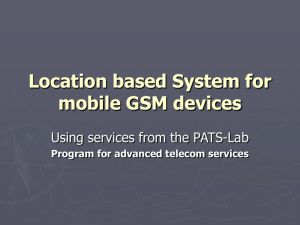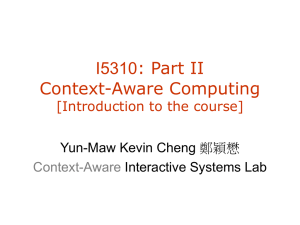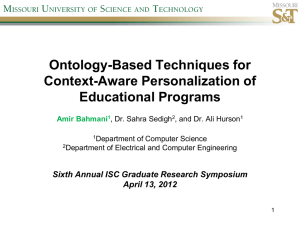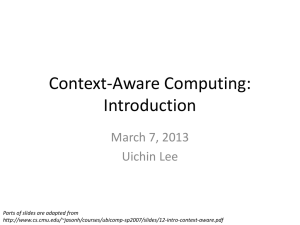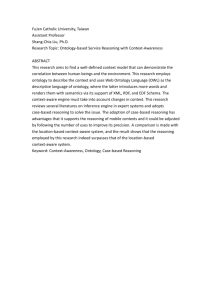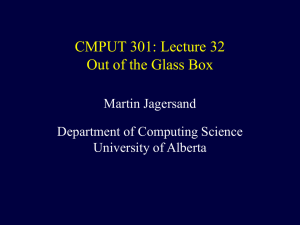International Journal of Application or Innovation in Engineering & Management... Web Site: www.ijaiem.org Email: Volume 4, Issue 5, May 2015
advertisement
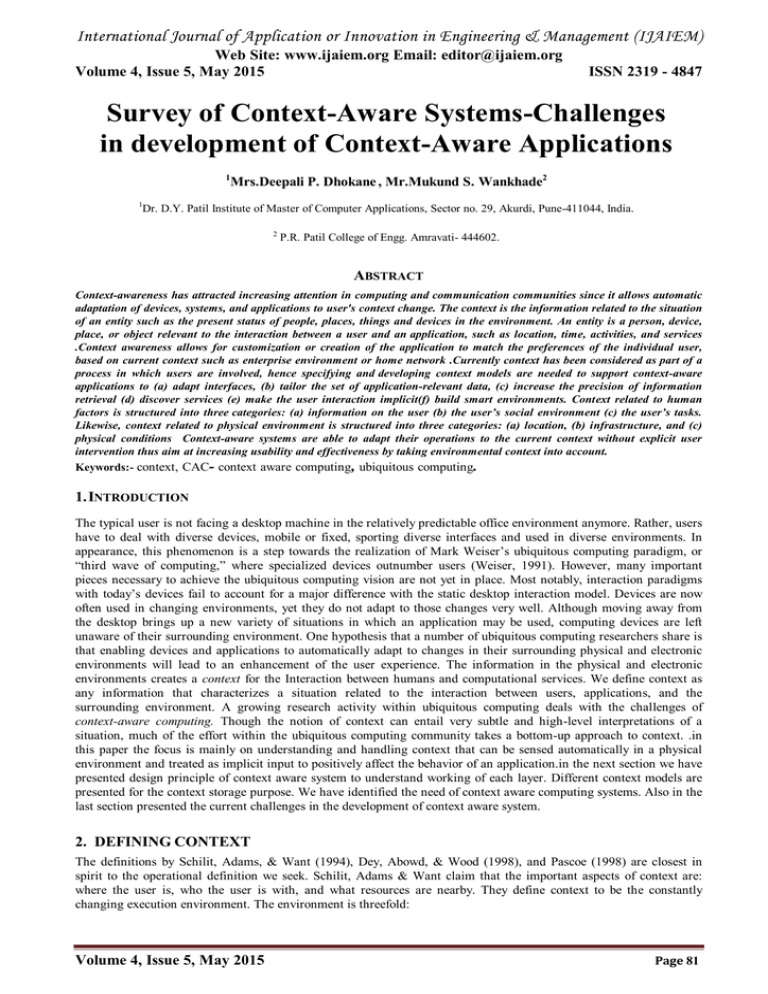
International Journal of Application or Innovation in Engineering & Management (IJAIEM) Web Site: www.ijaiem.org Email: editor@ijaiem.org Volume 4, Issue 5, May 2015 ISSN 2319 - 4847 Survey of Context-Aware Systems-Challenges in development of Context-Aware Applications 1 Mrs.Deepali P. Dhokane , Mr.Mukund S. Wankhade2 1 Dr. D.Y. Patil Institute of Master of Computer Applications, Sector no. 29, Akurdi, Pune-411044, India. 2 P.R. Patil College of Engg. Amravati- 444602. ABSTRACT Context-awareness has attracted increasing attention in computing and communication communities since it allows automatic adaptation of devices, systems, and applications to user's context change. The context is the information related to the situation of an entity such as the present status of people, places, things and devices in the environment. An entity is a person, device, place, or object relevant to the interaction between a user and an application, such as location, time, activities, and services .Context awareness allows for customization or creation of the application to match the preferences of the individual user, based on current context such as enterprise environment or home network .Currently context has been considered as part of a process in which users are involved, hence specifying and developing context models are needed to support context-aware applications to (a) adapt interfaces, (b) tailor the set of application-relevant data, (c) increase the precision of information retrieval (d) discover services (e) make the user interaction implicit(f) build smart environments. Context related to human factors is structured into three categories: (a) information on the user (b) the user’s social environment (c) the user’s tasks. Likewise, context related to physical environment is structured into three categories: (a) location, (b) infrastructure, and (c) physical conditions Context-aware systems are able to adapt their operations to the current context without explicit user intervention thus aim at increasing usability and effectiveness by taking environmental context into account. Keywords:- context, CAC- context aware computing, ubiquitous computing. 1. INTRODUCTION The typical user is not facing a desktop machine in the relatively predictable office environment anymore. Rather, users have to deal with diverse devices, mobile or fixed, sporting diverse interfaces and used in diverse environments. In appearance, this phenomenon is a step towards the realization of Mark Weiser’s ubiquitous computing paradigm, or “third wave of computing,” where specialized devices outnumber users (Weiser, 1991). However, many important pieces necessary to achieve the ubiquitous computing vision are not yet in place. Most notably, interaction paradigms with today’s devices fail to account for a major difference with the static desktop interaction model. Devices are now often used in changing environments, yet they do not adapt to those changes very well. Although moving away from the desktop brings up a new variety of situations in which an application may be used, computing devices are left unaware of their surrounding environment. One hypothesis that a number of ubiquitous computing researchers share is that enabling devices and applications to automatically adapt to changes in their surrounding physical and electronic environments will lead to an enhancement of the user experience. The information in the physical and electronic environments creates a context for the Interaction between humans and computational services. We define context as any information that characterizes a situation related to the interaction between users, applications, and the surrounding environment. A growing research activity within ubiquitous computing deals with the challenges of context-aware computing. Though the notion of context can entail very subtle and high-level interpretations of a situation, much of the effort within the ubiquitous computing community takes a bottom-up approach to context. .in this paper the focus is mainly on understanding and handling context that can be sensed automatically in a physical environment and treated as implicit input to positively affect the behavior of an application.in the next section we have presented design principle of context aware system to understand working of each layer. Different context models are presented for the context storage purpose. We have identified the need of context aware computing systems. Also in the last section presented the current challenges in the development of context aware system. 2. DEFINING CONTEXT The definitions by Schilit, Adams, & Want (1994), Dey, Abowd, & Wood (1998), and Pascoe (1998) are closest in spirit to the operational definition we seek. Schilit, Adams & Want claim that the important aspects of context are: where the user is, who the user is with, and what resources are nearby. They define context to be the constantly changing execution environment. The environment is threefold: Volume 4, Issue 5, May 2015 Page 81 International Journal of Application or Innovation in Engineering & Management (IJAIEM) Web Site: www.ijaiem.org Email: editor@ijaiem.org Volume 4, Issue 5, May 2015 ISSN 2319 - 4847 Computing environment: available processors, devices accessible for user input and display, network capacity, connectivity, and costs of computing: User environment: location, collection of nearby people, and social situation Physical environment: lighting and noise level Dey, Abowd, & Wood define context as the user's physical, social, emotional or informational state. Finally, Pascoe defines context to be the subset of physical and conceptual states of interest to a particular entity. Based on these prior attempts to define context, we will proceed with the following definition, taken from (Dey & Abowd, 2000a): Context: any information that can be used to characterize the situation of entities (i.e. whether a person, place or object) that are considered relevant to the interaction between a user and an application, including the user and the application themselves. Context is typically the location, identity and state of people, groups and computational and physical objects. This definition encompasses the definitions given by previous authors. As stated earlier, a Goal of context acquisition is to determine what a user is trying to accomplish. Because the User’s objective is difficult to determine directly, context cues can be used to help infer this Information and to inform an application on how to best support the user. The definition we have provided is quite general. This is because context-awareness represents a generalized model of input, including both implicit and explicit input, allowing almost any application to be considered more or less context-aware in so far as it reacts to input. The main goal for providing this definition of context is to offer guidance in identifying broad categories of context. Context aware computing: “software that examines and reacts to an individual’s Changing context.” Means “…aware of its user’s state and surroundings, and help to adapt its behavior” 3. NEED FOR CONTEXT AWARE (CAC) COMPUTING Context, critically required in Ubicomp Environment Mobile computing and ubiquitous computing have given users the expectation that they can access whatever information and services they want, whenever they want, and wherever they are. With computers being used in such a wide variety of situations, interesting new problems arise, and the need for context is clear: users are trying to obtain different information from the same services or systems in different situations. Context can be used to help determine what information or services to make available or to bring to the forefront for users. Input deficiency is resolved, by two basic approaches: Improving the language that humans can use to interact with Computers. Increasing the amount of situational information, or context that is made available to computers Need for explicitness does exist in human–computer interactions, because the computer does not share this implicit situational information or context The goal of context-aware computing is to use context as an implicit cue to enrich the impoverished interaction from humans to computers, making it easier to interact with computers. Smart phones having great computing power. Hi-Speed internet and wireless services. This two makes user’s context more dynamic. With ubiquitous computing, users move throughout an environment and interact with computer-enhanced objects within that environment. This also allows them to have access to remote information and services Our wearable system contains a radio link that connects the user to computing resources and services from the Internet The use of context in mobile device is receiving increasing attention in mobile and ubiquitous computing research. 4. DESIGN PRINCIPLES In this section we describe basic design principles of context-aware systems and explain the working of different layers involve in the layered architecture. Most of the context aware systems follow this layered architecture. A separation of detecting and using context is necessary to improve extensibility and reusability of systems. From the functional point of context-aware systems can be represented as a layered framework. Layered conceptual architecture, as depicted in Figure 1, augments layers for detecting and using context by adding interpreting and reasoning functionality (Ailisto et al., 2002; Dey and Abowd, 2001). Here we have explained about each layer in detail. 1) Sensors - The first layer consists of a collection of different sensors. Sensors are raw data from user’s environment it is notable that the word ‘sensor’ not only refers to sensing hardware but also to every data source which may provide usable context information. Concerning the way data is captured; sensors can be classified in three groups (Indulska and Sutton, 2003).266 M. Baldauf, S. Dustdar and F. Rosenberg Volume 4, Issue 5, May 2015 Page 82 International Journal of Application or Innovation in Engineering & Management (IJAIEM) Web Site: www.ijaiem.org Email: editor@ijaiem.org Volume 4, Issue 5, May 2015 ISSN 2319 - 4847 Applications CM S Storage /Management Pre-processing Raw data retrieval Sensors Figure 1 Layered conceptual framework for context-aware Systems 1. Physical sensors. The most frequently used type of sensors are physical sensors. Many hardware sensors are available nowadays which are capable of capturing almost any physical data. Commonly used physical sensor types are photodiodes, color sensors, IR and UV- sensor etc. for light sensing. Various cameras for visual context. Microphones for Audio data. Mercury switches, angular sensors, accelerometers, motion detectors, magnetic fields for Motion and acceleration detection. Outdoor location can be detected by Global Positioning System (GPS), Global System for Mobile Communications (GSM). And Indoor location detection by Active Badge System, etc. touch sensors are implemented in mobile devices. Temperature is sensed by thermometers. And the physical attributes are detected by Biosensors to measure skin resistance, blood pressure. 2. Virtual sensors. Virtual sensors source context data from software applications or services. For example, it is possible to determine an employee’s location not only by using tracking systems (physical sensors) but also by a virtual sensor, e.g., by browsing an electronic calendar, a travel-looking system, emails etc., for location information. Other context attributes that can be sensed by virtual sensors include, e.g., the user’s activity by checking for mousemovement and keyboard input. 3. Logical sensors. These sensors make use of a couple of information sources, and combine physical and virtual sensors with additional information from databases or various other sources in order to solve higher tasks. For example, a logical sensor can be constructed to detect an employee’s current position by analyzing logins at desktop PCs and a database mapping of devices to location information. 2) Raw data retrieval- The second layer is responsible for the retrieval of raw context data. It makes use of appropriate drivers for physical sensors and APIs for virtual and logical sensors. The query functionality is often implemented in reusable software components which make low-level details of Hardware access transparent by providing more abstract methods. By using interfaces for components responsible for equal types of context these components become exchangeable. Therefore, it is possible, for instance, to replace a RFID system by a GPS system without any major modification in the current and upper layers. 3) Pre-processing layer- is responsible for reasoning and interpreting contextual information. The sensors queried in the underlying layer most often return technical data that are not appropriate to use by application designers. Hence this layer raises the results of layer two to a higher abstraction level. The transformations include extraction and quantization operations. For example, the exact GPS position of a person might not be of value for an application but the name of the room the person is in, May be. IN context-aware systems consisting of several different context data sources, the single context atoms can be combined to high-level information in this layer. This process is also called ‘aggregation’ or ‘composition’. A single sensor value is often not important to an application, whereas combined information might be more precious and accurate. In this vein, a system is able to determine, e.g., whether a client is situated indoor or outdoor by analyzing various physical data like temperature and light or whether a person is currently attending a meeting by capturing noise level and location. To make this analysis work correctly a multitude of statistical methods are involved and often some kind of training phase is required. Obviously, this abstraction functionality could also be implemented directly by the application. But due to a couple of reasons this task should better be encapsulated and moved to the context server. The encapsulation advances the reusability and, hence, eases the development of client applications. And by making such aggregators remotely accessible the network performance increases (as clients have to send only one request to gain high-level data instead of connecting to various sensors) and limited client resources are saved. The problem of sensing conflicts that might occur when using several data sources Volume 4, Issue 5, May 2015 Page 83 International Journal of Application or Innovation in Engineering & Management (IJAIEM) Web Site: www.ijaiem.org Email: editor@ijaiem.org Volume 4, Issue 5, May 2015 ISSN 2319 - 4847 has to be solved in this layer as well. For example, when a system is notified about a person’s location by the coordinates of her mobile phone and by a camera spotting this person, it might be difficult to decide what information to use. Often this conflict is approached by using additional data like time stamps and resolution information. 4) Storage and Management- Organizes the gathered data and offers them via a public interface to the client. Clients may gain access in two different ways, synchronous and asynchronous. In the synchronous manner the client is polling the server for changes via remote method calls. Therefore, it sends a message requesting some kind of offered data and pauses until it receives the server’s answer. The asynchronous mode works via subscriptions. Each client subscribes to specific events it is interested in.On occurrence of one of these events, the client is either simply notified or a client’s method is directly involved using a call back. In the majority of cases the asynchronous approach is more suitable due to rapid changes in the underlying context. The polling technique is more resource intensive as context data has to be requested quite often and the application has to prove for changes itself, using some kind of context history. 5) Application layer- The actual reaction on different events and context-instances is implemented here. Sometimes information retrieval and application specific context management and reasoning is encapsulated in form of agents, which communicate with the context server and act as an additional layer between the pre-processing and the application layer (Chen, 2004). An example for context logic at the client side is the display on mobile devices: as a light sensor detects bad illumination, text may be displayed in higher color contrast. 4.1 Context models A context model is needed to define and store context data in a machine process able form. To develop flexible and useable context ontologies that cover the wide range of possible contexts is a challenging task. Strang and LinnhoffPopien (2004) summarized the most relevant context modelling approaches, which are based on the data structures used for representing and exchanging contextual Information in the respective system. 1. Key-Value models. These models represent the simplest data structure for context modelling. They are frequently used in various service frameworks, where the key-value pairs are used to describe the capabilities of a service. Service discovery is then applied by using matching algorithms which use these key-value pairs. 2. Markup scheme models. All markup based models use a hierarchical data structure consisting of markup tags with attributes and content. Profiles represent typical markup-scheme models. Typical examples for such profiles are the Composite Capabilities/Preference Profile (CC/PP) (W3C, 2004a) and User Agent Profile (UAProf) (Wapforum, 2001), which are encoded in RDF/S. various other examples can be found in Strang and Linnhoff-Popien (2004). 3. Graphical models. The Unified Modelling Language (UML) is also suitable for modelling context. Various approaches exist where contextual aspects are modelled in by using UML, e.g., Sheng and Benatallah (2005).Another modelling approach includes an extension to the Object-Role Modelling (ORM) by context information presented in Hendricksen et al. (2003). 4. Object oriented models. Modelling context by using object-oriented techniques offers to use the full power of object orientation (e.g., encapsulation, reusability, inheritance). Existing approaches use various objects to represent different context types (such as temperature, location, etc.), and encapsulate the details of context processing and representation. Access the context and the context processing logic is provided by well-defined interfaces. Hydrogen (Hofer et al., 2002) uses such an Object-oriented example. 5. Logic based models. Logic-based models have a high degree of formality. Typically, facts, expressions and rules are used to define a context model. A logic based system is then used to manage the aforementioned terms and allows to add, update or remove new facts. The inference (also called reasoning) process can be used to derive new facts based on existing rules in the systems. The contextual information needs to be represented in a formal way as facts. One of the first approaches was published by McCarthy and Buvac(1997). 6. Ontology based models. Ontologies represent a description of the concepts and relationships. Therefore, ontologies are a very promising instrument for modelling contextual information due to their high and formal expressiveness and the possibilities for applying ontology reasoning techniques. Various context-aware frameworks use ontologies as underlying context models. The conclusion of the evaluation presented in Strang and Linnhoff-Popien (2004), based on six requirements, show that ontologies are the most expressive models and fulfil most of their requirements. Korpipää et al. (2003) present some requirements and goals having designed a context ontology 5. REQUIREMENTS OF CONTEXT-AWARE APPLICATIONS A context-aware application has to take into consideration a set of characteristics Related to context modelling, handling and adaptation. Such characteristics could be: Context acquisition: A mechanism to obtain context data from diverse context sources. Context acquisition could be dealt with hardware and software sensors delivering information that conforms to a low-level data model. Context aggregation: A mechanism that provides context storing and integrity. In case of a shared context model, the context aggregation forms a basis for merging correlated contextual information. The context composition is a Volume 4, Issue 5, May 2015 Page 84 International Journal of Application or Innovation in Engineering & Management (IJAIEM) Web Site: www.ijaiem.org Email: editor@ijaiem.org Volume 4, Issue 5, May 2015 ISSN 2319 - 4847 specific kind of context aggregation, when the involved contexts are compatible with the same, or equivalent, context model. Context consistency: Context consistency enables the rationality of dynamically changing distributed context models. Such mechanism, regarded as being an extended context aggregation mechanism, maintains the structure of the contextual model into higher levels of abstraction. Context discovery: The aim of context discovery is to locate, and access contextual sources, in terms of serving context requests (e.g., discovering the appropriate, or approximate, context pertinent to an entity). Context discovery covers issues, such as, service description, advertisement, and discovery. Context query: By exploring contextual information, residing in distributed context repositories, a reference model needs a high-level mechanism for posing queries. Complex context retrieval tasks (e.g., queries as list all persons in the same conference hall whose presentation is at the same time with mine) must be transparent to endusers. Context query mechanism should, also, pose design issues as context query language (e.g., RDQL), query optimizations, trigger messages, and, definitions of constraints related to context acquisition. Context adaptation: The application should be capable of adapting its behavior according to contextual information. Specifically, it, automatically, adapts the system configuration in response to a contextual change. For instance, the application may configure itself to use the display device available to the user. Moreover, context adaptation can be achieved by IF-THEN rules used to specify how context-aware software should respond intelligently to contextual changes. Context reasoning: Context can be elaborated with reasoning mechanisms. Context reasoning is a process for inferring new context, previously unidentified on the basis of a-priori known context. Reasoning tasks check context consistency and deduce high-level context. Such tasks can be realized through logical schemes like firstorder predicates and description logics. Context quality indicators: Context data can come from heterogeneous context sources, such as, sensors, and software services. The lack of a universal context model and application-specific representation of the contextual data undermines the consistency of the sensed information. A mechanism for maintaining predefined sets of quality indicators is very important. Such indicators may be resolution, accuracy, repeatability, frequency, and staleness of context. Context integration: Context model outlines an expressive scheme for context representation and context interpretation. Existing context models vary in the expressiveness they support, in semantics, and in the abstraction level of the conceptual entities. Context model is based on (i) capturing general features of contextual entities, like activities, (ii) specific features, like temperature, and (iii) interrelations between contextual objects, like spatial relations. Contextual information integration (i.e., contextual semantic integration of the individuals of an ontology) can be conducted whenever different context models are in accordance, not only, with their semantics, but, also, with their similar domains of interest. 6. CHALLENGES IN DEVELOPMENT OF CONTEXT-AWARE SYSTEMS This section identifies the research challenges in context-aware computing. An adequate context aware system should overcome these challenges to leverage the promising potential of context-aware systems, providing high performance services. Some of the research challenges identified in context-aware computing are given below: 1) Defining the Context: The context is a vast concept that encompasses all possible parameters identifying a situation. The applications and frameworks must define the context and identify the relevant parameters limited by their scope. 2) Context-Aware Models: The context-aware architectures are still in their infancy. Most of the models and architectures are task specific. Standards and support tools are yet to be developed. 3) Sensing the Context Data: Context sensing devices are undergoing the development process. Wearable computing is a subfield of context-aware computing, that realizes the design and development of personalized context sensors. 4) Representing and Storing Context Information: The context representation scheme should facilitate the context interpretation and context sharing processes, and follow a standardized structure. 5) Inferring Context and Adapting System Behaviour: The interpretation of the context and adaptation of service behaviour is a prime challenge of context-awareness. The interpretation process is adaptation oriented. 6) Security and Privacy control: It is important to address security and privacy issues in context aware computing. The first security concern with context-aware system is about contextual data of the participating entities is private information, and must be secured from exposure to malicious entities, while in transit or at the storage device. And second is the need of secure communication. 7. CONCLUSION AND FUTURE WORK: In this paper major milestones have been achieved in the understanding, categorisation and development of contextaware systems. Context awareness is the major factor in development of new applications for ubiquitous mobile computing. Volume 4, Issue 5, May 2015 Page 85 International Journal of Application or Innovation in Engineering & Management (IJAIEM) Web Site: www.ijaiem.org Email: editor@ijaiem.org Volume 4, Issue 5, May 2015 ISSN 2319 - 4847 In conclusion, considering all the issues and aspects of context awareness highlighted here, still more understanding of requirements in design and development of context aware application is necessary.in the next research we are more focusing on security and privacy issues of context aware systems. Our future work in this area will investigate the use of service oriented concepts for building context aware systems, we will more focus on achieving security in communication. References [1]. Dey, A.K., Salber, D. Abowd, G.D., "A Conceptual Framework and a Toolkit for Supporting the Rapid Prototyping of Context-Aware Applications", Human- Computer Interaction (HCl) Journal, Vol. 16(2-4), pp. 97-166, 2001. [2]. Musumba GW, Nyongesa HO.Context awareness in Mobile computing: A review.Int J Machine Learn Appl. 2013;2(1), Art. #5, 10 pages.http://dx.doi.org/10.4102/ijmla.v2i1.5 [3]. M. Baldauf, S. Dustdar, and F. Rosenberg. A survey on context-aware systems. International Journal Int. J. Ad Hoc and Ubiquitous Computing, Vol. 2, No. 4, 2007 [4]. Anind K. Dey and Gregory D. Abowd A Conceptual Framework and a Toolkit for Supporting the Rapid Prototyping of Context-Aware Applications [5]. Intro to Context-Aware Computing Matthew Lee05-899 Special Topics in Ubiquitous Computing [6]. Context-Aware Computing Applications, by Bill Schilit, Norman Adams, and Roy Want [7]. Ask not for whom the cell phone tolls: Some problems with the notion of context-aware computing, by Tom Erickson [8]. Michael J.Franlin “Challenges in Ubiquitous Data Management” EECS Computer Science Division University Of California,Berkeley,CA 94720,USA [9]. Guanling chen and David Kotz “A Survey Of Context Aware Mobile Computing Research” Dartmouth computer science technical report TR2000-381 [10]. Baldauf M, Dustdar S, Rosenberg F. A survey on context-aware systems. Int J Ad Hoc Ubiquitous Computing. 2007; 2(4):263–277. http://dx.doi.org/10.1504/ IJAHUC.2007.01407 [11]. Weiser M. The computer for the 21st century. Scientific American. 1991;265(3):66– 75. http://dx.doi.org/10.1038/scientificamerican0991-94 [12]. Dey AK. Understanding and using context. Pers Ubiquitous Computing. 2001;5(1):4–7. http://dx.doi.org/10.1007/s007790170019 [13]. Long S, Kooper R, Abowd GD, Atkeson CG. Rapid prototyping of mobile contextaware applications: The Cyberguide case study. Wireless Networks. 1997;3:421– 433. http://dx.doi.org/10.1023/A:1019194325861 [14]. Schmidt A. Context-aware computing: context-awareness, context-aware user interfaces, and implicit interaction. In: Soegaard M, Dam RF, editors. The Encyclopedia of Human-Computer Interaction, 2nd edition. Aarhus, Denmark: The Interaction Design Foundation; 2013. [15]. Schmidt A. Context-aware computing: context-awareness, context-aware user interfaces, and implicit interaction. In: Soegaard M, Dam RF, editors. The Encyclopedia of Human-Computer Interaction, 2nd edition. Aarhus, Denmark: The Interaction Design Foundation; 2013. AUTHORS Mrs. Deepali P. Dhokane Received the Master Degree in Computer Science from HVPM, Amravati in 2005 Worked as Asst.Professor at 1Dr. D.Y. Patil Institute of Master of Computer Applications, Sector no. 29, Akurdi, Pune-411044, India . Mr. Mukund S. Wankhade Received Bachelor’s Degree in Computer Science And Engineering from Sant Gadge Baba Amravati University in W-2011 & Pursuing Master Degree In CSE from P.R. Patil College of Engg. Amravati- 444602. Volume 4, Issue 5, May 2015 Page 86
